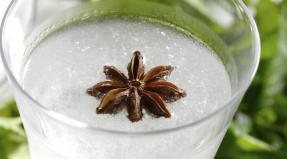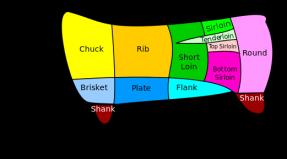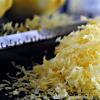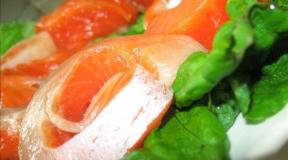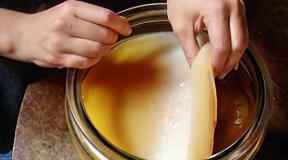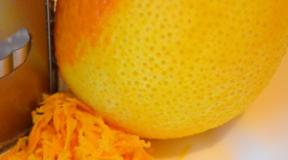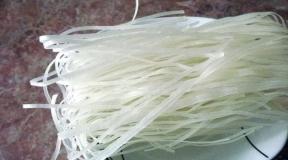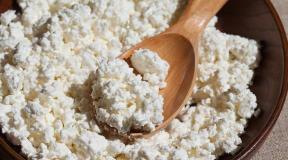Savoy cabbage: recipes with photos. Savoy cabbage: healing properties and healthy cooking recipes
Many of our tourists who have been abroad (in European countries, the USA, Canada) note that cabbage in local restaurants and taverns (in various dishes, salads and pies) is more tender, fragrant and tastier than ours. The point here is not the skill of the cooks, but the fact that Savoy cabbage is preferred here. Savoy cabbage, unfortunately, is not so popular with us, although its benefits are so great that it deservedly bears the title of "queen of vegetables."
Did you know? The type of cabbage, which was first bred in the small Italian duchy of Savoy in the 17th century, was called "savoy". In Italy, this cabbage is called Milanese, Lombard (Savoy was part of Lombardy). Czechs and Poles call it French (in the 19th century Savoy became part of France). The French king Louis XIV fell in love with her very much, even granted a title of nobility with a coat of arms (three cabbage heads of cabbage with two crossed spades) to the royal gardener. Every year in Udine, Italians celebrate the Sagra holiday - in honor of Savoy cabbage, where you can taste dozens of dishes from it.
Savoy cabbage: calories, vitamins and minerals
For those who do not know what Savoy cabbage looks like, it should be said that outwardly it is very similar to its sister - ordinary white cabbage. But there are also differences:
- the head of cabbage is loose, has a looser structure;
- the leaves are soft, delicate and embossed (coarse fibers are absent);
- color is saturated green.

The main differences relate to its vitamin and mineral composition. Savoy cabbage contains more useful substances than many other types (the amount of protein exceeds white cabbage twice). Cabbage leaves contain:
 It should be said that Savoy cabbage with its unique chemical composition, its low calorie content (28.2 kcal) makes this vegetable a valuable dietary product, useful for children and the elderly, pregnant and lactating women, and for those who want to lose weight.
It should be said that Savoy cabbage with its unique chemical composition, its low calorie content (28.2 kcal) makes this vegetable a valuable dietary product, useful for children and the elderly, pregnant and lactating women, and for those who want to lose weight.Did you know? Savoy cabbage appeared in Russia in the 19th century. The reason for its low popularity is often called unsuitability for pickling (although this is only partly true - this cabbage can be pickled). Savoy cabbage is unpretentious: it is frost-resistant (does not freeze at -14°C ), grows on soils with a high salt content (since the 17th century in Holland, it has been used to desalinate the soil).
What is useful savoy cabbage for the human body
The beneficial properties of Savoy cabbage and easy absorption by the body are due to its unique composition:
 Saying how Savoy cabbage is useful, its juice should be mentioned. Cabbage juice is used as a remedy against microbes and to counteract inflammation (in the treatment of peptic ulcers, gastritis, colitis, etc.), as a vitamin preparation. With stomatitis, periodontal disease, tonsillitis, rinsing the mouth with a mixture of cabbage juice and water (1: 1) is recommended. The juice of this cabbage effectively removes the morning hangover syndrome (250 ml of juice mixed with 30 g of sugar).
Saying how Savoy cabbage is useful, its juice should be mentioned. Cabbage juice is used as a remedy against microbes and to counteract inflammation (in the treatment of peptic ulcers, gastritis, colitis, etc.), as a vitamin preparation. With stomatitis, periodontal disease, tonsillitis, rinsing the mouth with a mixture of cabbage juice and water (1: 1) is recommended. The juice of this cabbage effectively removes the morning hangover syndrome (250 ml of juice mixed with 30 g of sugar). Important! The only cabbage that contains the sugar alcohol mannitol (used as a sweetener) is Savoy cabbage. This property is especially useful for diabetics.
How to choose the right savoy cabbage when buying
When buying Savoy cabbage, you should follow simple rules:
- heads of savoy cabbage should not be dense - they should give in to hand when pressed;
- you should choose heads of regular round shape;
- the leaves must be without flaws (damage, rot, etc.), be evenly green (depending on the variety - light or dark). White or yellow shades, brownish spots, cobwebs, white bloom are unacceptable (signs of cabbage pests).
Did you know? The origin of the word "cabbage" comes from the Latin word "caputum" - "head" (among the Celts, the word "cap" also meant head). The origin of the plant itself is shrouded in mystery. Georgia, Spain, Italy and Greece claim the right to be called the birthplace of this super-healthy vegetable.
How best to store savoy cabbage
 When buying several heads of savoy cabbage, or when a portion of a head remains after cooking, the question arises how to keep it fresh for some time. It should be borne in mind that Savoy cabbage is more tender than white cabbage, and this negatively affects its storage - it loses moisture faster.
When buying several heads of savoy cabbage, or when a portion of a head remains after cooking, the question arises how to keep it fresh for some time. It should be borne in mind that Savoy cabbage is more tender than white cabbage, and this negatively affects its storage - it loses moisture faster.Cabbage should be placed in a plastic bag or wrapped in cling film and placed in the vegetable storage compartment of the refrigerator. So it will keep its freshness for 3-4 days.
When it comes to whether Savoy cabbage is suitable for storage, whether it should be left for the winter or not, then the opinion is expressed that it is not stored for a long time. This is not entirely true. Cabbage bought at the supermarket will be difficult to keep until spring. The reason is that it all depends on its variety. You won't always be able to tell which variety it is.
 Early varieties of savoy cabbage are not suitable for preservation, no matter what conditions you give them. For long-term storage (from 4 to 6 months), medium-late and late varieties (Uralochka, Ovasa F1, Valentina, Lacemaker, etc.) are suitable, which differ in darker shades of green.
Early varieties of savoy cabbage are not suitable for preservation, no matter what conditions you give them. For long-term storage (from 4 to 6 months), medium-late and late varieties (Uralochka, Ovasa F1, Valentina, Lacemaker, etc.) are suitable, which differ in darker shades of green.By growing your own Savoy cabbage, you can control which variety to plant. For the correct laying of cabbage for storage, you must:
- do not water it on the eve of collection, cut it in dry, cool weather;
- select whole heads of cabbage (0.5 kg) without rot and dry;
- cut the stump (no more than 3 cm);
- optimal conditions for storage: in a dark room at a temperature of 0 to +3 ° C at 90% humidity (basement, cellar);
- the method of storage (in wooden boxes, hanging or “pyramid”) does not really matter. The main thing is that there should be a distance of several centimeters between heads of cabbage.
Important! Savoy cabbage can be dried for the winter. Drying (at a temperature of 50-60 ° C) allows you to save all the vitamins and minerals. Cabbage, finely chopped, is dried in one layer in an electric dryer or oven (with conversion). Dried cabbage will change color to grayish or yellowish (becomes lighter when cooked). Properly dried cabbage can retain its properties for up to two years.
What to cook with savoy cabbage
What can you cook with savoy cabbage? In principle, everything that is usually prepared from white cabbage. Savoy cabbage has a stronger flavor and aroma. The methods of cooking it are somewhat different from the traditional ones: Savoy cabbage is tender, the leaves are thinner and devoid of coarse veins. It is easy to digest, which will spoil the taste, and useful substances will be lost. A few general cooking rules:
 Regarding whether it is possible to stew Savoy cabbage, it should be noted that in the process of stewing it is very boiled. Vinegar will help prevent cabbage from softening, which is recommended to sprinkle it during cooking.
Regarding whether it is possible to stew Savoy cabbage, it should be noted that in the process of stewing it is very boiled. Vinegar will help prevent cabbage from softening, which is recommended to sprinkle it during cooking. Speaking about the popular ways of cooking Savoy cabbage, it should be noted its fresh use in salads. The number of only Italian traditional recipes for such salads is two dozen.
One of them is with avocado, pepper and shrimp. Salad requires two bell peppers, 200 g tomatoes, 400 g Savoy cabbage, eight tiger prawns (boiled), soy sauce, salt, olive oil, rosemary. Marinate shrimp in sauce. Soak rosemary in oil. Chop the cabbage and vegetables, mix everything, pour over with oil, add shrimp.
The taste of Savoy cabbage is enhanced and emphasized by spices (anise, basil, marjoram, ginger, balsamic vinegar, juniper, etc.). Cabbage goes well with red fish, sour cream, tomatoes and cucumbers.
Important! To provide the body with vitamins, minerals and other necessary substances, it is enough to include savoy cabbage in your menu twice a week (use at least 200 g each).
 Recipes from Savoy cabbage amaze with their diversity - it is stewed, fried, baked, cutlets, schnitzels, pies, etc. are made from it. One of the most popular dishes is cabbage rolls with pork and beef, baked in the oven.
Recipes from Savoy cabbage amaze with their diversity - it is stewed, fried, baked, cutlets, schnitzels, pies, etc. are made from it. One of the most popular dishes is cabbage rolls with pork and beef, baked in the oven.For one head of cabbage you will need: minced beef and pork (250 g each), broth, onions (2 pieces), carrots (2 pieces), three celery stalks, olive oil, black pepper, oregano, salt. Cooking process:
- rinse the cabbage, sort by leaves;
- prepare vegetables (cut the onion into eight pieces and disassemble into petals, cut the celery and carrots into large pieces);
- heat the oil in a frying pan and fry sliced vegetables for 5 minutes;
- blanch the leaves, transfer to a container with ice water. Lay out to dry;
- finely chop non-condite leaves, the second onion. Fry in olive oil;
- mix roast, thyme and oregano with minced meat;
- wrap minced meat (a tablespoon) in cabbage leaves and form cabbage rolls (fold them in an envelope);
- transfer the vegetable roast to a heat-resistant container, lay the cabbage rolls, pour in the broth, cover with foil;
- preheat the oven to 180 degrees and bake for 15-20 minutes.
 Savoy cabbage schnitzels are very popular. The cooking process is simple: boil cabbage leaves in milk, roll up, dip in a mixture of beaten egg and ground walnuts and fry.
Savoy cabbage schnitzels are very popular. The cooking process is simple: boil cabbage leaves in milk, roll up, dip in a mixture of beaten egg and ground walnuts and fry.
Savoy cabbage is a source of vitamins: PP, A, B1, B2, B6, B7, B8, B9, C, K. The mineral spectrum is quite large - 17 elements. A lot of potassium, zinc, iron, phosphorus, sulfur. Nutritional value is indicated by protein (1.2 g), carbohydrates (6 g), insoluble fibers (0.6 g), starchy substances (0.5 g), organic compounds - 0.1 g, fats - 0.1 g. The amount of water exceeds 90%.
Savoy cabbage contains a lot of pectins and amino acids. High concentration of glutathione (natural antioxidant), tartronic acid (a unique fat burner). Savoy cabbage stands out among other types of low calorie content (Brussels - 35 kcal, broccoli - 34 kcal, kohlrabi - 42 kcal).
How does it affect the body
Savoy cabbage is useful for normalizing metabolism, stimulating motility and gastrointestinal functions. Cabbage strengthens blood vessels, has a beneficial effect on the heart muscle, and increases vitality. It has bactericidal, wound healing, diuretic properties. With regular use, the composition of the blood improves, a sedative effect appears, insomnia is eliminated, and capillary blood supply is restored. Fresh cabbage reduces sugar levels, cleanses the intestines, eliminates constipation, and normalizes blood pressure. There is a positive effect on vision, skin, teeth and hair condition.
The beneficial properties of cabbage include the ability to maintain DNA molecules unchanged, which prevents negative changes in the body from occurring. The ability to block the progression of cancer cells, increase immunity, have an astringent and antioxidant effect has been proven. Helps to eliminate liver diseases, gastritis, ulcerative formations.
Savoy cabbage strengthens the musculoskeletal system, promotes weight loss and keeps the body in good shape. Invaluable benefits for obesity: vitamin B7 and B8 (biotin, inositol) prevent the conversion of carbohydrates into fats, restore lipid metabolism, block the deposition of subcutaneous and visceral fat.
How to choose
A good head of Savoy cabbage is moderately loose. The leaves have a rich green color, there are no hard veins, the middle is light yellow on the cut. The presence of dark spots, yellowness and rot is a sign of damage and poor quality.
Storage methods
Savoy cabbage does not have a high keeping quality. If after the purchase it was not possible to use the whole vegetable, then you should not wet it, put it in the refrigerator. A plastic film or a closed container will protect the head of cabbage from drying out and withering. In this state, cabbage will remain usable for 5-10 days.
What is combined with in cooking
Savoy cabbage is well suited for preparing fresh salads, can be stewed, delicious fried, serves as an amazing filling for pancakes and pies. Used for cabbage rolls, vegetable stews, complex casseroles and side dishes. Combines with beef, chicken, pork. It is used in first courses, hodgepodges, vegetable purees. Harmonious with carrots, tomatoes, onions, zucchini, potatoes, eggplants. The vegetable is not subject to salting, pickling and pickling.
Useful food combination
Savoy cabbage is one of the leading nutritional products. Low calorie content and a unique set of nutrients are used in weight loss techniques. Compared to white cabbage, it has more protein and saturates well. Cabbage is indispensable in low-calorie diets - it perfectly fills the stomach, eliminates hunger.
To normalize metabolism, it is recommended to combine with radish, carrots, celery root. It is useful to use with ginger, carrots, parsley, dill, bell pepper, fresh cucumber. It is added to salads with boiled chicken breast, mushrooms, pineapples. For dressing use lemon juice, soy sauce, corn or pumpkin oil. There is an effective drink for weight loss.
Recipe for weight loss: 100 g juice of savoy cabbage and green radish, a teaspoon of honey. Drink a glass before meals (40 minutes before), use once a day. For a month it takes 4-7 kg.
Contraindications
Savoy cabbage is not recommended for enterocolitis, pancreatitis, high acidity, indigestion, thyroid dysfunction. In limited quantities with flatulence. In large doses in men, the formation of the seed worsens.
Application in medicine and cosmetology
Savoy cabbage is included in the treatment tables for diabetes, dysbacteriosis, swelling, hypertension, intestinal inflammation, problems with the spleen, liver. In boiled form, it is recommended for ulcers, gastritis, and systematic constipation. For the treatment of vitamin deficiency, 150 g of Savoy cabbage juice is prescribed daily on an empty stomach. Fresh leaf compresses are used for eczema, burns, herpes zoster. Dressings with juice promote wound healing. At night, leaves are applied to muscle seals, hematomas, and tumors. Freshly squeezed juice, diluted with water (1:1), is used for periodontal disease, tonsillitis, stomatitis.
In cosmetology, juice and gruel from foliage are productive. Included in recipes for anti-aging, tonic procedures. Used for oily and problematic skin. Helps eliminate cracks and puffiness.
Savoy cabbage got its name from the Italian region of Savoy, where it has been cultivated since ancient times. In appearance, this vegetable is similar to white cabbage, but the Savoy leaves have a richer color and resemble corrugated paper. The taste of Savoy cabbage is much milder, as it contains less mustard oil and coarse fibers. The vegetable gives a unique taste and pleasant aroma to salads, first courses, pies, side dishes.
Benefit
Savoy cabbage is useful to include in the diet for dietary nutrition.
It has a low energy value, but it is nutritious, as it is rich in easily digestible proteins. It contains a lot of fiber, which contributes to better digestion and bowel cleansing. Savoy cabbage diet helps to get rid of a few unnecessary pounds, keeping the body in excellent shape and saturating the body with all the necessary substances.
Benefits of Savoy Cabbage:
- contains natural antioxidants, the most powerful of which - glutathione prevents the formation of cancer cells, prolongs the youth of the body, normalizes the functioning of the nervous system;
- contains the substance ascorbigen, which neutralizes the effect of various poisons, including carcinogens, and also reduces the growth of female hormones, which contribute to the formation of malignant tumors of the genital organs and the mammary gland;
- natural sweetener, which is contained in its leaves, allows you to use a vegetable for diabetes;
- due to a significant amount of vitamin C, it strengthens the immune system, promotes the rapid removal of harmful cholesterol, prevents the development of skin diseases, increases the body's endurance;
- has diuretic properties;
- returns appetite;
- gently relieves pressure;
- accelerates the growth and development of children;
- helps to maintain the health of the body of the elderly.
Savoy cabbage masks are good for all skin types. These products lighten freckles and pigmentation, refresh and tone, saturate dehydrated skin with moisture, and get rid of unhealthy oily sheen. The chopped vegetable can be used as a soft scrub. Savoy cabbage juice, rubbed into the scalp, strengthens the hair, promotes its growth and adds shine to the hairstyle.
Harm
Savoy cabbage, consumed in large quantities, can cause increased gas formation and exacerbate diseases of the gastrointestinal tract.
The amount of saturated fat and carbohydrates in the vegetable is minimal. Savoy cabbage does not contain GMOs and carcinogens.
calories
The energy value of 100 g of Savoy cabbage is 28.2 kcal, which is 1.35% of the recommended rate per day. Calorie data for 1 medium head of cabbage are presented in the table:
Contraindications
Savoy cabbage is not contraindicated during pregnancy. However, expectant mothers who have digestive problems, suffer from heartburn, and bloating should not get carried away with this product: cabbage can aggravate the situation.
Savoy cabbage is contraindicated in the diet of children under 7 months. From this age, the vegetable can be given to the child only in boiled form (steamed). An infant's early exposure to Savoy cabbage can cause colic and disrupt the digestive process. The use of fresh cabbage by a child up to a year old can lead to the same consequences. A thermally unprocessed vegetable can be offered in small quantities to a baby after 12 months.
Savoy cabbage should be avoided during the recovery period after abdominal or thoracic surgery. The vegetable is contraindicated in exacerbation of peptic ulcers, gastritis, pancreatitis.
The nutritional value
Vitamins and minerals
| Vitamin name (chemical name) | ||
| beta carotene | 0,6 | 30 |
| Vitamin A (retinol) | 0,05 | 5 |
| Vitamin B1 (thiamine) | 0,07 | 6,09 |
| Vitamin B2 (riboflavin) | 0,03 | 2,2 |
| Vitamin B5 (pantothenic acid) | 0,187 | 2,87 |
| Vitamin B6 (pyridoxine) | 0,19 | 16,91 |
| Vitamin B9 (folic acid) | 0,08 | 40 |
| Vitamin C (ascorbic acid) | 31 | 37,2 |
| Vitamin E (tocopherol) | 0,17 | 1,7 |
| Vitamin B4 (choline) | 12,3 | 2,03 |
| Vitamin K (phylloquinone) | 0,0688 | 76,46 |
| Vitamin PP (nicotinic acid) | 0,6 | 3 |
| Vitamin PP (niacin equivalent) | 0,3 | 1,5 |
Minerals in Savoy Cabbage:
| Mineral name | Content per 100 g Savoy cabbage (mg) | % of the recommended norm per day |
| Potassium | 230 | 4,73 |
| Calcium | 35 | 2,98 |
| Magnesium | 28 | 8,4 |
| Sodium | 20 | 2 |
| Sulfur | 15 | 3 |
| Phosphorus | 42 | 5,78 |
| Chlorine | 47 | 1,14 |
| Aluminum | 0,815 | 81,5 |
| Bor | 0,1 | 3,335 |
| Iodine | 0,002 | 0,6 |
| Iron | 0,4 | 3,8 |
| Cobalt | 0,001 | 1,05 |
| Manganese | 0,18 | 10,8 |
| Copper | 0,135 | 13,77 |
| Molybdenum | 0,01 | 10 |
| Fluorine | 0,014 | 0,7 |
| Zinc | 0,27 | 3,17 |
Savoy cabbage is a natural source of all the vitamins and minerals the body needs. The maximum amount of valuable substances is stored in a vegetable that has not undergone heat treatment. Cabbage absorbs fats well, therefore, in dishes for medical or dietary nutrition, it is necessary to include it only fresh.
Savoy cabbage is a vegetable crop related to the type of cabbage garden. Varietal group - sabauda. To date, the vegetable is not widely used in Russia. This is due to the short shelf life, low yield compared to white cabbage, and this variety is not used for fermentation. Savoy cabbage can be consumed both fresh and added to salads, soups, stews, and preparations for the winter. There are a large number of recipes for dishes from this vegetable.
Characteristic
Savoy cabbage was first bred in Italy over 500 years ago. It received its name in honor of one of the duchies, which was located in the north of the state and disappeared from the map of Europe in the 18th century. In Italy, the vegetable is known as Milanese or Lombard cabbage, and in the Czech Republic as French.
Its appearance is very reminiscent of whitehead, but it has unusual corrugated leaves, which are very much appreciated. The advantages of the vegetable include its delicate taste. It can often be found in a variety of dishes in the United States and Canada.
Savoy cabbage is resistant to diseases and temperature fluctuations, it is not harmed by drought and frost down to -7°C. The yield of the vegetable is lower than that of the white cabbage, and its shelf life is only 2 months. Caring for Savoy cabbage is simple and does not differ from the requirements for keeping other varieties. The plant propagates with the help of seedlings. For 1 m², the yield of a vegetable is 8 kg.
Beneficial features
The benefits of Savoy cabbage are very high. The biochemical composition of the vegetable is rich in easily digestible protein, as well as various micro and macro elements necessary for the normal functioning of all organs and systems of the human body. Among them are the following substances:
- mustard oils - participate in the normalization of the digestive and cardiovascular systems, have a positive effect on the walls of blood vessels and capillaries, help to quickly activate fat metabolism;
- chlorophyll - protects cells from mutation;
- dietary fiber - contribute to the normalization of bowel function;
- phytoncides - strengthen the immune system;
- a complex of vitamins and minerals, including B vitamins, folic acid, selenium, aluminum, copper, sulfur, calcium, potassium, beta-carotene.
The vegetable contains a rare vitamin U, which is necessary for the normal functioning of the liver, as well as vitamin K, which human blood needs.
Folic acid, contained in Savoy cabbage, is an important vitamin that is needed primarily by pregnant women. If the body of the expectant mother is deficient in this substance, various defects in the neural tube of the fetus may appear. There is also the possibility of anencephaly (malformation of the brain), spinal pathology and problems with the limbs. Folic acid is involved in the transfer of carbohydrates, it improves the metabolism of amino acids and the synthesis of nucleic acids. The action of the substance is aimed at the process of formation of new cells and DNA copying.
Vitamin C contained in the vegetable reduces the risk of developing gout, the presence of which can be determined by the painful condition of the big toe. The disease occurs due to the presence of excess uric acid in the joints. Studies have shown that regular consumption of savoy cabbage reduces the risk of gout by 30%. The composition of the vegetable contains soluble fibers, which help in slowing down the digestion process and ensure the maintenance of optimal human blood sugar levels. This increases the sensitivity of diabetic patients to insulin. There is also an inverse relationship between dietary fiber in the blood and glucose levels. If you consume a large amount of soluble fiber, the body's resistance to insulin, which is formed when glucose levels rise, decreases.
Savoy cabbage contains vitamins C, A, D and K, which reduce the risk of gum and oral disease. Frequent consumption of vegetables helps to eliminate bacteria that multiply in this area. The interaction of vitamin K with other substances prevents the development of various diseases that cause caries and damage tooth enamel. The effect of vitamin K is also observed in improving metabolic processes and starting the work of sphingolipids - molecules that are found in cell membranes. This substance also has anti-inflammatory properties and has an antioxidant effect caused by radicals. Oxidation provokes Alzheimer's and Parkinson's diseases.
Savoy cabbage contains a large amount of bioactive substances that have antioxidant properties. These elements include:
- glutathione - aimed at neutralizing radicals, helps protect the body from carcinogens, slows down the aging process of cells;
- ascorbigen - inhibits the reproduction of cancer cells and helps to destroy them;
- polyphenols - do not allow the development of atherosclerosis, ischemia and other diseases associated with neurology.
Savoy cabbage is an indispensable food product that has other benefits:
- 1. Helps to get rid of edema and excess weight.
- 2. Normalizes to pressure.
- 3. Helps to saturate the human body with useful substances.
- 4. Favorably affects bone tissue and strengthens the immune system.

Harm and contraindications
Savoy cabbage is not harmful in moderation, but its frequent use can provoke increased gas production, as well as diseases of the gastrointestinal tract.
Vegetable is contraindicated in children under 8 months. Up to 1 year old, Savoy cabbage can be given to a child only after heat treatment (preferably boiled) and in small quantities. Otherwise, the baby may develop colic and indigestion.
The use of vegetables during the recovery period after operations in the chest and abdominal cavity is contraindicated. You can not eat cabbage of this variety in the presence of ulcers, pancreatitis and gastritis.

Recipes
Savoy cabbage can be cooked in a variety of ways. It is suitable for main dishes and snacks, and is also harvested for the winter (salted or marinated, the vegetable can be boiled and blanched beforehand).
The most popular recipes are stewed, stuffed cabbage and cabbage rolls.
Braised Savoy Cabbage in Creamy Sauce
To prepare this dish you will need the following products:
- savoy cabbage - 800 g;
- white onion - 1 pc.;
- salt to taste;
- butter - 2 tbsp. l.;
- flour - 2 tsp ;
- cream - 250 ml;
- vegetable broth - 100 ml;
- cumin - 2 tsp ;
- parsley - 1 bunch;
- ground black pepper;
- freshly squeezed lemon juice - 0.5 cups.
You should chop the onion. Cabbage must be cleaned from the upper coarse leaves and cut out the head. Vegetable leaves should be cut into small strips of 2 cm. Cabbage should be placed in salted boiled water and boiled for 5 minutes. After that, the liquid should be drained, and the vegetable should be left in a colander.
In a pre-melted oil in a saucepan, you need to fry the onion. To give the dish an unforgettable taste, you can add flour in the process. After that, you need to pour the cream and broth. Using a whisk, it is necessary to thoroughly mix the entire contents of the container. The sauce should cook for 7 minutes, while stirring it.
Add cabbage, parsley, cumin to the pan. You need to extinguish all this for 5 minutes, the fire should be weak. Then the dish must be peppered, salted and sprinkled with lemon juice.
Cabbage rolls with mushrooms
The necessary ingredients for the preparation of cabbage rolls are:
- savoy cabbage - 1 head;
- boiled rice - 300 g;
- mixed minced meat - 300 g;
- mushroom caviar - 300 g;
- ground black pepper;
- salt;
- broth - 1 glass;
- ketchup - 3 tbsp. l. ;
- sour cream - 5 tbsp. l. ;
- margarine - 100 g.
To prepare this dish, cabbage is processed in the same way as for ordinary cabbage rolls. First you need to remove the leaves and steam them in hot water. You need to cut off the thickenings from them. To make the filling, you need to mix rice with minced meat, then salt and pepper to taste. Mushroom caviar should be added to them. The entire contents of the container must be mixed well. After that, the minced meat must be laid out on cabbage leaves and wrapped. It is important to be careful when doing this, as the leaves are very delicate, they can be easily torn. Twisted cabbage rolls must be placed in a deep baking sheet, on the bottom of which you need to lay out the top removed leaves.
To prepare the dressing in hot water, place the following ingredients: margarine or butter and a bouillon cube. Ketchup and sour cream must be added to the broth. Everything must be thoroughly mixed, and the prepared dressing must be poured over the cabbage rolls. It should completely cover them in the pan.
The top of the cabbage rolls should be covered with leaves. The dish should be baked in the oven, while it will not burn, since the lower layer of leaves protects against this. Stuffed cabbage can be covered with a lid, in which case it is not necessary to spread the leaves on top. Bake the dish at a temperature of +180 degrees for 1 hour. Cooking time can be affected by the thickness of the cabbage rolls. After baking, the cabbage rolls are recommended to be put on a plate and sprinkled with a small amount of greens.
stuffed cabbage
Required Ingredients:
- small savoy cabbage - 1 pc.;
- vegetable oil - 2 tbsp. l. ;
- diced red pepper - 2 tbsp. l.;
- onions - 2 pcs.;
- rice vinegar - 1 tbsp. l.;
- garlic - 1 clove;
- soy sauce - 2 tbsp. l. ;
- chopped ginger - 2 tbsp. l. ;
- boiled rice - 1/2 cup;
- washed canned white beans - 1 cup;
- canned chestnuts - 250 g;
- bread;
- canned tomatoes - 800 g.
It is necessary to remove the top two leaves of cabbage, cut out the middle of the head. A funnel-like hole should form. The cut cabbage needs to be chopped. As a result, it can take about 2 glasses.
Heat a large frying pan over low heat, add 1 tbsp. l. oils. When it melts, put pepper, half an onion in a container and fry them for 10 minutes until a golden crust appears. In the pan, add chopped cabbage, vinegar, 1 tbsp. l. soy sauce, garlic and 1 tbsp. l. ginger and cook 5 minutes. The pan should be removed from the heat, after which rice, chestnuts and beans should be poured into it.
Cabbage must be stuffed with the resulting vegetable mixture, then covered with leaves and tied with a rope. After that, you need to heat the cast-iron pan over low heat, add 1 tbsp. l. oils and onions. The mixture should be fried for 5 minutes. Then you need to pour 1 tbsp. l. ginger and cook for 30 seconds.
You need to put the tomatoes with juice on a plate and mash them using the edge of a spoon. Then add a glass of water and 1 tbsp. l. soy sauce. Put cabbage in the resulting tomato mass and cover the top with leaves. The dish must be stewed for 1 hour. Serving cabbage should be carried out on a large dish, you need to remove the ropes in advance. Vegetables can be poured with sauce and cut into slices. It is recommended to serve the dish with French bread.
In nature, there are, each of which provides a unique health benefit. The second most popular after - the most tender savoy cabbage. Its leaves are softer and sweeter in taste than many other varieties.
Savoy cabbage is widely used in cooking- it is prepared in various ways. In addition to being used in a number of dishes, savoy cabbage is loaded with numerous nutrients and is incredibly healthy.
Useful and medicinal properties of savoy cabbage
For those who want to have a strong immune system, slim figure and radiant skin, you should definitely include this healthy vegetable in your daily diet.
Savoy cabbage leaves are very useful in treating ulcers, cancer, depression and boosting the immune system. The use of this vegetable activates the process of wound healing, regulates the normal functioning of the nervous system, reduces the possibility of Alzheimer's disease and other degenerative nervous diseases.
Savoy cabbage contains an incredible amount of fiber. Lack of coarse fiber in the diet leads to constipation, stomach ulcers, headaches, cancer of the gastrointestinal tract, indigestion and loss of appetite.
Other dietary benefits of savoy cabbage include:
- protection against the development of cancer;
- anti-inflammatory properties;
- delayed cataract formation;
- aid in weight loss;
- lowering cholesterol;
- activation of mental activity and concentration;
- protecting bones from osteoporosis;
- powerful shield against high pressure;
- reduction in muscle pain.
A significant amount of important minerals and vitamins in cabbage is good for expectant mothers and the fetus. During pregnancy, eating savoy cabbage improves the digestion of food, as well as the overall metabolic process.
Savoy cabbage is useful at any age, especially for children. Also, this vegetable is safe for diabetics.
Chemical composition
Raw leaves are incredibly nutritious but low in fat and calories (28 kcal/100 g). Savoy cabbage contains slightly less fiber than its relatives due to the lack of stems in the leaves.
There are a lot of savoy cabbages vitamin C even more than oranges. Vitamin C protects the body from free radicals, preventing the cause of premature aging.
Vitamins:
Sulfur- a very useful element in the human body. Sulfur deficiency leads to microbial infection and significantly reduces wound healing. There is enough sulfur in savoy cabbage to reduce the incidence of infections.
Trace elements:
Savoy cabbage, rich iodine, thanks to which, the normal functioning of the nervous system occurs, along with the preservation of the glands of the endocrine system in proper condition.
Macronutrients:
As you can see, Savoy cabbage has enough potassium- an important component of cells and body fluids.
Application in dietetics and for weight loss
By eating this vegetable, you can be guaranteed to lose weight. A sufficient amount of fiber keeps you full for longer. Fiber additionally provides an increased metabolic rate.
There are special detox diet, vegetable and cabbage diet, thanks to which it is easy to get rid of extra pounds without compromising health.
Culinary compatibility
Cabbage leaves are eaten raw, added to salads, boiled in soups, stewed and fermented.
This vegetable is consumed with various products:
- with other vegetables (potatoes, beets, carrots, cucumbers, radishes, radishes);
- with meat (chicken, turkey, beef, lamb);
- with fish (trout, tuna, salmon, saury);
- with seafood (squid, shrimp, octopus);
- with fruits (apples, avocado, quince, banana, kiwi);
- with berries (cranberries, lingonberries);
- with herbs (onion, parsley, dill, cilantro, basil);
- with cereals (rice, barley, millet);
- with nuts (hazelnuts, peanuts, pine nuts).
Milk and beans should not be paired with this type of cabbage, as this is too much load on the liver.
Savoy Cabbage Recipes
In order for the body to receive the maximum value, it is recommended to consume this vegetable raw or boil. What can be cooked from savoy cabbage?
Recipe with photo of savoy cabbage salad with avocado

- head of cabbage;
- lemon;
- radish;
- seasonings.
Separate the cabbage leaves and place on a plate. Cut the avocado and radish into cubes, peel the orange, divide into slices, chop the nuts. Put chopped food on the leaves, sprinkle with lemon juice, add seasonings.
Detox Soup

- head of cabbage;
- 1 large apple;
- 3 carrots;
- root ;
- head ;
- 3 arrows;
- stem;
- lemon;
- tooth .
Send the chopped onion head, chopped leek, ginger and two carrots to a three-liter saucepan to cook for about 40 minutes. Strain the finished broth and add chopped cabbage, carrots, an apple to it; squeeze lemon, garlic and leave to cook for another 10 minutes. Puree the finished soup.
Creamy Savoy Cabbage

- ½ head of cabbage;
- 2 stalks of leek;
- 1 piece;
- 2 cloves of garlic.
Finely chop the onion and cabbage, boil in boiling water (5 minutes), then style with water. Melt the butter in a frying pan, add the garlic and fry for a minute. Add the cabbage and saute for about 3 minutes, seasoning with salt and pepper.
How to choose a good product
Savoy cabbage is available all year round. When buying, you should choose fresh, compact, firm heads of medium size.
How to use the product
Savoy cabbage is suitable as a low-calorie dinner as an addition to meat. Enough ½ head per day to normalize the functioning of the body.
Product storage features
 Pests often attack Savoy cabbage. Heads grown in the traditional way are processed insecticidal sprays. Therefore, before use or storage, it is necessary to thoroughly wash the head of cabbage in cold running water, then soak in salt water for about 30 minutes. Then rinse again in clean water to remove sand, dirt, pests and insecticide residue.
Pests often attack Savoy cabbage. Heads grown in the traditional way are processed insecticidal sprays. Therefore, before use or storage, it is necessary to thoroughly wash the head of cabbage in cold running water, then soak in salt water for about 30 minutes. Then rinse again in clean water to remove sand, dirt, pests and insecticide residue. Savoy cabbage should be cooked on the day of purchase to get the most health benefits. It is better to store the vegetable in the refrigerator for no longer 3 days.
Harm and contraindications
Eating large amounts of cabbage causes unwanted gas, loose bowels, and thyroid problems. Other symptoms of flatulence are belching, abdominal pain, and bloating.
Adding kale to your daily meal, be it salad or soup, is a small change that will help you live a healthier, longer life.
What dishes do you cook with savoy cabbage? When choosing between white cabbage and savoy cabbage, which option would you prefer?
